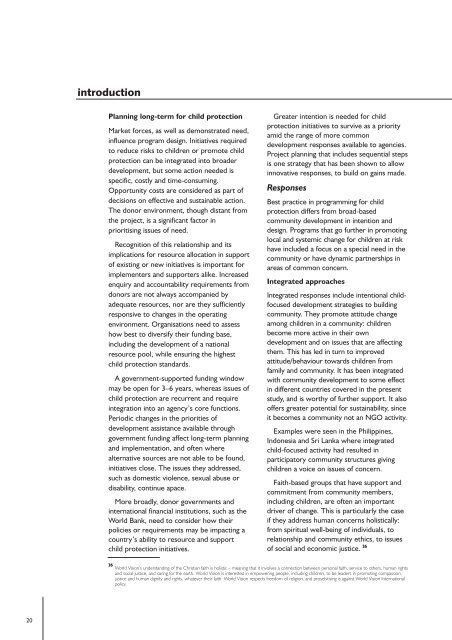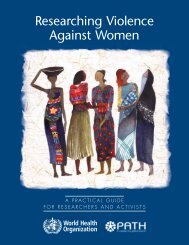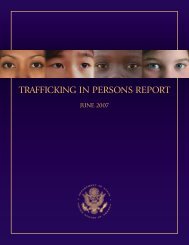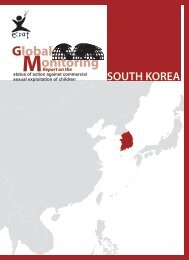Download PDF - Violence Against Children - East Asia and the ...
Download PDF - Violence Against Children - East Asia and the ...
Download PDF - Violence Against Children - East Asia and the ...
You also want an ePaper? Increase the reach of your titles
YUMPU automatically turns print PDFs into web optimized ePapers that Google loves.
introduction<br />
Planning long-term for child protection<br />
Market forces, as well as demonstrated need,<br />
influence program design. Initiatives required<br />
to reduce risks to children or promote child<br />
protection can be integrated into broader<br />
development, but some action needed is<br />
specific, costly <strong>and</strong> time-consuming.<br />
Opportunity costs are considered as part of<br />
decisions on effective <strong>and</strong> sustainable action.<br />
The donor environment, though distant from<br />
<strong>the</strong> project, is a significant factor in<br />
prioritising issues of need.<br />
Recognition of this relationship <strong>and</strong> its<br />
implications for resource allocation in support<br />
of existing or new initiatives is important for<br />
implementers <strong>and</strong> supporters alike. Increased<br />
enquiry <strong>and</strong> accountability requirements from<br />
donors are not always accompanied by<br />
adequate resources, nor are <strong>the</strong>y sufficiently<br />
responsive to changes in <strong>the</strong> operating<br />
environment. Organisations need to assess<br />
how best to diversify <strong>the</strong>ir funding base,<br />
including <strong>the</strong> development of a national<br />
resource pool, while ensuring <strong>the</strong> highest<br />
child protection st<strong>and</strong>ards.<br />
A government-supported funding window<br />
may be open for 3–6 years, whereas issues of<br />
child protection are recurrent <strong>and</strong> require<br />
integration into an agency’s core functions.<br />
Periodic changes in <strong>the</strong> priorities of<br />
development assistance available through<br />
government funding affect long-term planning<br />
<strong>and</strong> implementation, <strong>and</strong> often where<br />
alternative sources are not able to be found,<br />
initiatives close. The issues <strong>the</strong>y addressed,<br />
such as domestic violence, sexual abuse or<br />
disability, continue apace.<br />
More broadly, donor governments <strong>and</strong><br />
international financial institutions, such as <strong>the</strong><br />
World Bank, need to consider how <strong>the</strong>ir<br />
policies or requirements may be impacting a<br />
country’s ability to resource <strong>and</strong> support<br />
child protection initiatives.<br />
Greater intention is needed for child<br />
protection initiatives to survive as a priority<br />
amid <strong>the</strong> range of more common<br />
development responses available to agencies.<br />
Project planning that includes sequential steps<br />
is one strategy that has been shown to allow<br />
innovative responses, to build on gains made.<br />
Responses<br />
Best practice in programming for child<br />
protection differs from broad-based<br />
community development in intention <strong>and</strong><br />
design. Programs that go fur<strong>the</strong>r in promoting<br />
local <strong>and</strong> systemic change for children at risk<br />
have included a focus on a special need in <strong>the</strong><br />
community or have dynamic partnerships in<br />
areas of common concern.<br />
Integrated approaches<br />
Integrated responses include intentional childfocused<br />
development strategies to building<br />
community. They promote attitude change<br />
among children in a community: children<br />
become more active in <strong>the</strong>ir own<br />
development <strong>and</strong> on issues that are affecting<br />
<strong>the</strong>m. This has led in turn to improved<br />
attitude/behaviour towards children from<br />
family <strong>and</strong> community. It has been integrated<br />
with community development to some effect<br />
in different countries covered in <strong>the</strong> present<br />
study, <strong>and</strong> is worthy of fur<strong>the</strong>r support. It also<br />
offers greater potential for sustainability, since<br />
it becomes a community not an NGO activity.<br />
Examples were seen in <strong>the</strong> Philippines,<br />
Indonesia <strong>and</strong> Sri Lanka where integrated<br />
child-focused activity had resulted in<br />
participatory community structures giving<br />
children a voice on issues of concern.<br />
Faith-based groups that have support <strong>and</strong><br />
commitment from community members,<br />
including children, are often an important<br />
driver of change. This is particularly <strong>the</strong> case<br />
if <strong>the</strong>y address human concerns holistically:<br />
from spiritual well-being of individuals, to<br />
relationship <strong>and</strong> community ethics, to issues<br />
of social <strong>and</strong> economic justice. 26<br />
26 World Vision’s underst<strong>and</strong>ing of <strong>the</strong> Christian faith is holistic – meaning that it involves a connection between personal faith, service to o<strong>the</strong>rs, human rights<br />
<strong>and</strong> social justice, <strong>and</strong> caring for <strong>the</strong> earth. World Vision is interested in empowering people, including children, to be leaders in promoting compassion,<br />
justice <strong>and</strong> human dignity <strong>and</strong> rights, whatever <strong>the</strong>ir faith. World Vision respects freedom of religion, <strong>and</strong> proselytising is against World Vision International<br />
policy.<br />
20

















